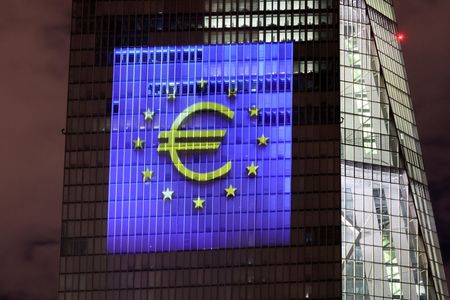By Dhara Ranasinghe
LONDON (Reuters) -Battered euro zone bonds recovered ground on Thursday, but were set to end March with one of their biggest selloffs in years as rising inflation and rate-hike risks left German Bund yields on track for their biggest monthly jump since 2009.
Most 10-year yields across the single currency bloc fell 6-8 basis points, a day after high German and Spanish inflation prints triggered fresh selling.
Data on Thursday showed inflation in Italy hit 7% while prices in France were up 5.1%, but a more than 5% fall in oil prices brought some comfort to bond investors.
Surging inflation, which has raised expectations that the European Central Bank may have to hike interest rates sooner rather than later, and a more aggressive stance from the U.S. Federal Reserve have sent bond markets reeling.
Germany’s 10-year Bund yield, down eight basis points (bps) at 0.57%, is up 42 bps in March and set to end the month with the biggest monthly surge since 2009. If yields rise much further they would be on track for the biggest move since 1996.
Two-year German yields, trading just under 0%, have jumped around 45 bps this month – poised for their biggest monthly rise since 2011.
Dutch and French 10-year bond yields were set for their biggest monthly rises since 2012 and 2011 respectively, with monthly rises over 40 bps each.
“This is very significant,” said ING senior rates strategist Antoine Bouvet. “A move of this magnitude will have investors reassess the riskiness of their bonds portfolio and have market participants who thought their rates risk was negligible until now hedge it.”
Euro zone inflation is increasingly likely to stabilise around 2% but the ECB should be ready to change course if the outlook deteriorates due to Russia’s war in Ukraine, ECB chief economist Philip Lane said.
“The ECB has relatively high inflation, but actually, inflation’s undershot for a long period of time and the (euro zone) economy is not overheating to the same extent (as the U.S),” said Andrew Sheets, chief cross-asset strategist at Morgan Stanley.
“There’s also more flexibility at the ECB and I think the ECB would like to take rates to zero and get ahead of negative rate policy.” The ECB’s deposit rate is at -0.50%.
Yield surges in euro area bond tracked similar milestones in other major debt markets.
U.S. 2-year Treasury yields are up around 85 bps in March, set for their biggest monthly increase since 1989, according to Refinitiv data. They are up 155 bps this quarter, on track for the biggest quarterly jump since 1984.
(Reporting by Dhara RanasingheEditing by Mark Potter, William Maclean and John Stonestreet)





